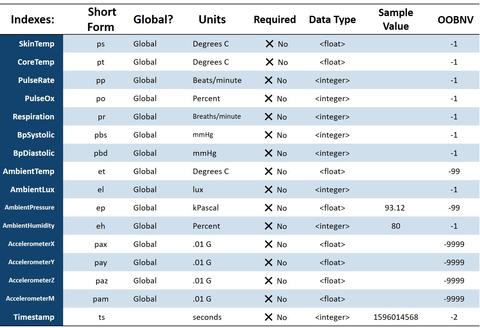Responder Health Schema
Responder Health Schema (object name: pHealth)
Describes the health and direct environmental information of a responder

NOTES:
This schema utilizes the following naming conventions for the beginning character of the Short Index name:
- 'p' fields related to a responder’s health
- 'e' fields used for environment telemetry
- 'l' fields related to a GPS location—uses Global elements from the GPS object
This schema makes use of a 4-index grouping for the accelerometer:
- AccelerometerX: acceleration along the X axis
- AccelerometerY: acceleration along the Y axis
- AccelerometerZ: acceleration along the Z axis
- AccelerometerM: magnitude of the X, Y, and Z axes.
This structure produces a small increase in the size of the object but makes the data significantly more readable.
Additional Perspective
This schema shows the value of the global index parameter. With these global values, the developer can take environmental measurements and include them in a responder health object to transmit the immediate environmental conditions at the responder’s location.
As referenced in the body of the document earlier, there is a significant problem in identifying an individual in a consistent manner. Attributes for a responder could include identifiers such as:
- The department a person is associated with at the time of reporting the health data. For fire and EMS, this may be the FDID.
- The PSAP or regional agency a person is associated with at the time of reporting.
- A universal, lifelong identifier for responder health and exposure information. This may be something along the lines of a 64-bit unique number that is randomly generated the 1st time a person is involved with any agency that tracks or accumulates health and exposure information.
In IoT systems, the data values obtained tend to be sent to a larger sever. In such systems, a responder ID is often assigned. As an example, that may be the primary key for the responder table in that server’s database. The burden is then on that server to use information about the role that responder has in the incident to provide better and more universal identification.

